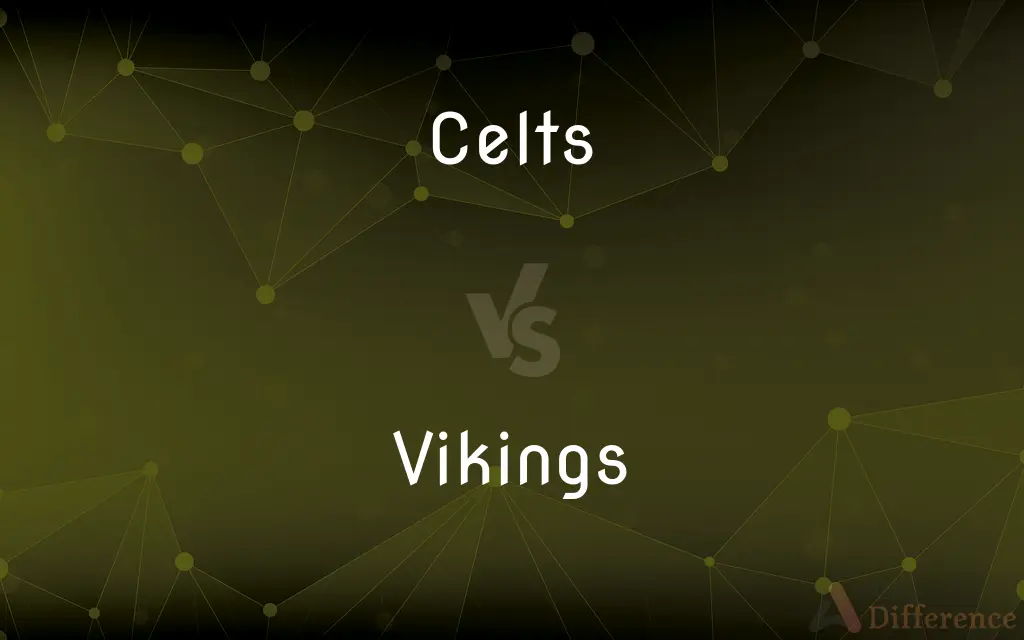Celts vs. Vikings — What's the Difference?
Edited by Tayyaba Rehman — By Urooj Arif — Published on May 9, 2024
Celts were ancient Indo-European peoples of Europe, known for their art and society, while Vikings were Norse seafarers, famous for their raids and exploration.

Difference Between Celts and Vikings
Table of Contents
ADVERTISEMENT
Key Differences
The Celts were a diverse group of tribal societies in Iron Age and Medieval Europe who shared linguistic roots and cultural similarities. They occupied areas now known as Britain, Ireland, France, and parts of Central Europe. The Celts were renowned for their intricate metalwork, art, and complex societal structures. Their society was organized into clans and tribes, and they had a rich oral tradition and mythology. The Celts did not have a unified political structure, which made them susceptible to conquest by the Romans and later by Germanic peoples.
Vikings, originating from Scandinavia (modern-day Norway, Sweden, and Denmark), emerged prominently from the late 8th to the early 11th century. They were known for their seafaring abilities, which allowed them to raid, trade, and settle across vast areas, including the British Isles, the North Atlantic, and into the Mediterranean. Unlike the Celts, Vikings left a significant historical impact through their expeditions, establishing settlements and integrating with local cultures. Their society was characterized by a strong warrior culture, with a social structure that included jarls (nobles), karls (freemen), and thralls (slaves).
While the Celts are celebrated for their contributions to European art, mythology, and cultural heritage, the Vikings are often remembered for their exploration, martial prowess, and the role they played in shaping medieval European history. The Celts' influence is seen in the cultural and linguistic heritage of Celtic nations, while the Viking legacy includes their impact on navigation, warfare, and the political landscape of Europe.
The interaction between Celts and Vikings occurred mainly through Viking raids into Celtic lands and subsequent settlements, particularly in Ireland and Scotland. This interaction led to a mix of cultures, evident in art, language, and historical records. Despite their differences, both the Celts and Vikings have left a lasting legacy on the cultural fabric of Europe.
Celtic society was deeply religious, with a class of druids who served as priests, teachers, and legal authorities. The Vikings, on the other hand, followed Norse mythology, with a pantheon of gods and a strong belief in fate and the afterlife. Both cultures' religious and mythological beliefs have profoundly influenced literature, art, and modern neo-pagan practices.
ADVERTISEMENT
Comparison Chart
Era
Iron Age to Medieval Europe
Late 8th to early 11th century
Region
Europe (Britain, Ireland, France, Central Europe)
Scandinavia, British Isles, North Atlantic
Contributions
Art, mythology, societal structure
Exploration, warfare, settlement
Society
Clans and tribes, no unified political structure
Warrior culture, structured social hierarchy
Legacy
Cultural and linguistic heritage in Celtic nations
Impact on European navigation, warfare, and politics
Religion
Druidism, polytheistic beliefs
Norse mythology, pantheon of gods
Interaction
Mainly through Viking raids into Celtic lands
Established settlements in Celtic territories
Compare with Definitions
Celts
Ancient Indo-European peoples known for their art and society.
The Celts created intricate metalwork, which is displayed in museums today.
Vikings
Norse seafarers known for their raids, trade, and exploration.
Vikings established trade routes that extended as far as the Byzantine Empire.
Celts
Their society was organized into clans and tribes without a unified political structure.
Celtic tribes often engaged in warfare and alliances with each other.
Vikings
Their society included a strong warrior culture and social hierarchy.
Viking warriors were celebrated in sagas and tales of their expeditions.
Celts
Deeply religious, with a class of druids.
Druids played a central role in Celtic society as spiritual leaders.
Vikings
Originated from Scandinavia and impacted much of medieval Europe.
Viking settlers founded what is now known as the city of Dublin, Ireland.
Celts
Occupied areas now known as Britain, Ireland, and parts of Central Europe.
Celtic languages and traditions are still prevalent in parts of the British Isles.
Vikings
Followers of Norse mythology with a belief in a pantheon of gods.
Norse myths about gods like Odin and Thor are well-known today.
Celts
Renowned for their complex societal structures and oral traditions.
Celtic myths and legends have been passed down through generations.
Vikings
Their legacy includes contributions to navigation and European politics.
Vikings were among the first Europeans to reach North America.
Celts
One of an Indo-European people originally of central Europe and spreading to western Europe, the British Isles, and southeast to Galatia during pre-Roman times, especially a Briton or Gaul.
Vikings
One of a seafaring Scandinavian people who raided the coasts of northern and western Europe from the eighth through the tenth century.
Celts
A native speaker of a modern Celtic language or a descendant of such a speaker, especially a modern Gael, Welsh person, Cornish person, or Breton.
Vikings
Plural of viking
Celts
A common prehistoric tool of stone or metal, shaped like a chisel or axe head.
Common Curiosities
How did religious beliefs of the Celts and Vikings influence their cultures?
Both cultures were deeply influenced by their religious beliefs, which permeated their societal norms, art, and mythology. Druidism and Norse mythology shaped their worldviews, practices, and artistic expressions.
What contributed to the Vikings' ability to raid and explore far from their homeland?
Their advanced seafaring technology, including the design of their longships, and navigational skills allowed Vikings to travel vast distances, raid coastal sites, and establish settlements far from Scandinavia.
Did Celts and Vikings ever interact?
Yes, Vikings raided and settled in Celtic territories, leading to cultural exchanges.
How did Celtic and Viking societies differ in structure?
Celtic society was organized into clans and lacked a unified political structure, whereas Viking society had a clear social hierarchy and was organized around warrior culture.
What are some lasting legacies of the Celts and Vikings?
The Celts left a lasting legacy in art, language, and culture, especially in areas where Celtic traditions are still observed. Vikings significantly influenced navigation, warfare, and the political landscape of medieval Europe.
What evidence do we have of the Celts' existence and culture?
Evidence of the Celts comes from archaeological finds, ancient Roman and Greek texts, and the oral traditions that were later written down. Artifacts such as jewelry, weapons, and the famous Gundestrup Cauldron provide insight into their craftsmanship and societal values.
How did the Vikings navigate their longships across vast oceans?
Vikings used various navigational tools and techniques, including the sun compass, landmarks, and possibly the sunstone, a type of crystal believed to help locate the sun on cloudy days. Their extensive knowledge of the sea and stars also played a crucial role in their navigational abilities.
How did Vikings view their gods and the afterlife?
Vikings had a polytheistic belief system with gods like Odin, Thor, and Freya. They believed in Valhalla, a hall where warriors slain in battle were said to go and live gloriously. Their beliefs in fate and the afterlife were central to their worldview and actions in life.
How did the Viking Age come to an end?
The Viking Age is generally considered to have ended with the defeat of Harald Hardrada at the Battle of Stamford Bridge in 1066. The integration of Viking territories into the emerging nations of Europe, Christianity's spread, and changes in European political structures also contributed to the end of the Viking era.
Why did the Celts not form a unified empire like the Romans?
The Celts were culturally and linguistically connected but politically fragmented into various tribes and clans, each with its own leadership. This lack of centralization made it difficult to unite against common enemies, unlike the Romans who had a strong central government.
What role did Viking women play in their society?
Viking women had significant roles within their society, including managing the household, farming, and sometimes participating in trade. They also had rights that were somewhat progressive for the time, such as the ability to own property and request a divorce.
What is the significance of Stonehenge to the Celts?
While Stonehenge predates the Celts, it has often been associated with them, particularly the Druids, due to romanticized connections made during the Renaissance. Modern archaeology suggests that it was used by pre-Celtic peoples for astronomical observations and ceremonies.
Were there any notable conflicts between Celts and Vikings?
Yes, there were several conflicts, especially as Vikings raided and eventually settled in Celtic lands, including Scotland, Ireland, and the Isle of Man. These interactions ranged from raids and battles to the integration of Viking settlers into Celtic societies.
How have the languages of the Celts and Vikings influenced modern languages?
Celtic languages have influenced modern English, Welsh, Irish, Scottish Gaelic, and Breton, contributing vocabulary and place names. Old Norse, the language of the Vikings, has also left a significant imprint on the English language, especially in vocabulary related to seafaring, law, and daily life.
What impact did Celtic and Viking cultures have on modern societies?
Celtic and Viking cultures have influenced modern societies in various ways, including literature, art, and mythology. Celtic music and festivals are celebrated worldwide, while Viking symbols and stories have permeated popular culture, evident in movies, TV shows, and literature.
Share Your Discovery

Previous Comparison
VLAN vs. SubnetAuthor Spotlight
Written by
Urooj ArifUrooj is a skilled content writer at Ask Difference, known for her exceptional ability to simplify complex topics into engaging and informative content. With a passion for research and a flair for clear, concise writing, she consistently delivers articles that resonate with our diverse audience.
Edited by
Tayyaba RehmanTayyaba Rehman is a distinguished writer, currently serving as a primary contributor to askdifference.com. As a researcher in semantics and etymology, Tayyaba's passion for the complexity of languages and their distinctions has found a perfect home on the platform. Tayyaba delves into the intricacies of language, distinguishing between commonly confused words and phrases, thereby providing clarity for readers worldwide.













































